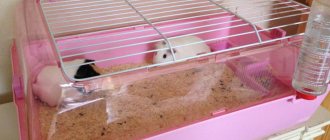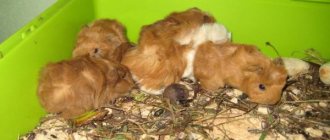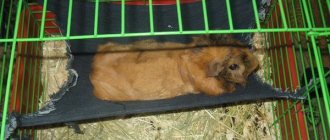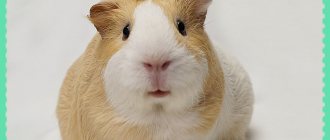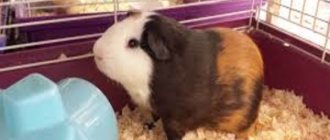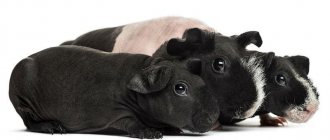Is your guinea pig already accustomed to the house and owner? The question arises, what can you do to keep your pet occupied for the benefit of his mind? In this case, there is a simple solution - training. Training a dog is a common thing, but you can also learn a few simple tricks with rodents. And if the owner and the pet like the activities, then you can teach the pig more complex commands.
Principles of training
The guinea pig is quite receptive to learning. Its training should be based on the development of the necessary conditioned reflexes. The main task is being solved - the animal performs certain actions that are, in fact, natural for it, but carried out at the right time and on command. Stimulation of such behavior is achieved by rewards that are important to the animal.
A conditioned reflex is developed in the following sequence: receiving a command (signal), performing a certain action, receiving a reward (encouragement). Basic principles of training:
- Stimulation. To determine the stimulus, you need to take a good look at the pet and its habits and tastes. Petting helps in training, but cannot be the main reward. A favorite treat is best, especially one offered before the main feeding. Foods such as carrots, tomatoes, bell peppers, celery, other vegetables and herbs are suitable as incentives.
- Signal for triggering the reflex. The animal must clearly associate its specific action with a pronounced sound signal. Such a command is given by a whistle, click, word, knock, i.e., a clearly distinguishable sound. You can use a whistle or clicker.
- Action. You cannot demand impossible actions from an animal. The behavior should be natural and liked by the animal itself.
- From simple to complex. Training should start with simple actions. Only after mastering them can you move on to more complex tricks.
The “command-action-reward” chain must have a constant sequence. The pet must be sure that after following the command, he will definitely receive his favorite treat, and immediately. Developing the necessary conditioned reflexes requires patience, perseverance, and a careful and affectionate attitude towards the animal from the owner. The animal's trust is an important factor in successful training.
Upbringing
Raising a pig does not begin on the first day it arrives in the house. First, the animal is allowed to get comfortable, tamed, and then shown what is allowed to do in the house and what is strictly prohibited.
You need to tame the animal from the first days of life in the house. For this:
- Immediately after the rodent appears, it is placed in a cage, which is covered with dense material. This way, the pet will not be distracted by visual sensations, but will get used to the sounds and smells.
- At first, the owner should talk to the pet in as calm and gentle a voice as possible.
- After some time, you can offer the animal a treat from your hands.
- After a week, the dense material is replaced with a lighter and more transparent one.
- After another week, the cape on the cage is removed. After this, the owner must leave the room so that the pet can look around.
After taming, you can and should begin raising your pet. The first thing you need to pay attention to is safety. This applies to both pet and owner. Rodents need to wear down their teeth, so they can chew on any objects they like. This could be furniture, wires, small things left in its path. To prevent property damage you need to:
- Monitor your pet's behavior when the animal is on a walk.
- Place the cage in a space free of foreign objects. That is, there should be no things near the cage that the rodent could reach.
- Close the cage carefully to prevent the pig from escaping.
If an animal constantly gnaws on an object while walking, it is recommended to apply a special gel or solution to the favorite item. This product has a bitter taste, but at the same time is absolutely harmless to animals. To wean yourself from damaging things, you need to apply the product regularly.
Where to start
Training a guinea pig at home begins with studying the pet's habits, gaining trust and teaching the animal basic tricks and certain behavior. This animal, by its nature, is quite cautious and timid, not aggressive, but can become aggressive if it senses danger. Trust is earned through affection and care. Loud noises and sudden movements can cause stress. Hand training should be done carefully and gradually.
The first step is learning to respond to the name. The pet's name should be repeated every time you bend over the cage. It is especially important to say the name when feeding. Gradually, the animal begins to instinctively understand: if the owner calls a nickname, then you need to approach him. This action is taught in the following way. The pig is removed from the cage and placed at a certain distance. A treat is taken in the hand and the pet’s name is called, the command “Come to me” is said. The animal will definitely come up, feeling that it is being treated. Gradually the distance increases, and eventually he will approach the owner from anywhere in the room, hearing his nickname. The conditioned reflex “Come to me” can also be associated with a specific signal (for example, a click or a whistle).
Another initial action that needs to be taught is “serve”, i.e. standing on the hind legs. Training is quite simple. The treat is raised above the pet’s head and the call “Serve” is pronounced. The animal, willy-nilly, rises on its hind legs to reach the treat. Constant repetition of the exercise leads to the development of a reflex - when the word “Serve” is said, the pet stands in the appropriate stance.
The trick associated with the game involves teaching the pet to spin around an imaginary axis. The training is as follows. The treat is held in front of the animal’s nose (a little higher than it), and the hand begins to slowly make a circular motion around the animal. At the same time, the command “Around” sounds. The exercise begins with one revolution. The number of turns gradually increases. After completing the exercise, the pet must receive a treat.
Another simple trick is the “kiss”. Learning occurs through mouth-to-mouth feeding. The owner holds a sprig of herbs (for example, celery or parsley) in his lips and brings his face closer to the pet. The animal, attracted by the treat, begins to chew the twig, which resembles a kiss. Frequent repetition of the exercise leads to the fact that the pig begins to instinctively reach for the owner’s lips. Over time, you can remove the branch from the mouth, but after the “kiss” you should reward the animal.
Toilet training
You need to accustom your pet to the tray in several stages.
- Observation. As soon as the pig appears in the house, you need to find out in which corner of the cage he prefers to relieve himself.
- Installing the tray.
- Bait. Place hay, bedding or some pet excrement in the tray.
- Encouragement.
After the pet relieves itself in the right place, it is encouraged. This must be done the first few times, then the animal will use the tray out of habit.
Tray training does not always go smoothly. Sometimes pigs change the location of the toilet after installing the tray. Then they put in a second tray, or remove both. Animals can use the toilet area as a bed or storage area. In this case, you need to reconsider the arrangement of the cage; perhaps your pet has an uncomfortable bed or storage area for hay.
It happens that a pet cannot learn to do its business in the tray when the inconvenience is eliminated. Then they remove the tray and allow the pet to go to the toilet where it is convenient for him.
Making tricks more difficult
After mastering simple actions, you can complicate the training. We recommend several interesting tricks that are more difficult for a guinea pig. Stretching out its paw is not a very natural behavior for her. But this can be taught.
Training is carried out in this order. The animal is placed on a sofa or chair, and the owner sits on the floor. He extends one hand towards the pet, palm up. In the second hand, located a little further, there is a piece of “yummy”. The pig wants to reach for the treat, but the outstretched palm interferes. The animal has to rest one paw on the palm in order to get to the food. At this moment, the command “Give me a paw” or simply “Paw” sounds and a treat is given. Over time, the animal will put its paw on its palm simply on a signal, knowing that it will receive encouragement.
The pig “footballer” looks original. To teach her to roll a ball, you need to provide appropriate training. A flat slice of carrot or a sprig of herbs is placed under a small ball (for example, a tennis ball). Together with the command “Ball” or “Roll”, the pig rolls away the obstacle with its paw, freeing the product. With frequent repetition of the exercise, the animal develops a reflex of rolling the ball.
A real circus act - jumping through the ring. Training includes the following exercise. A ring with a diameter of 20-30 cm is installed between the animal and the treat. At the command “Ring” or “Jump” the pig rushes to the food. If your pig is hesitant to jump, you can give him a gentle push. Gradually the ring rises higher, and treats can be given from the hands. It is important to develop the necessary reflex. The height of the ring above the floor should not exceed 4-5 cm.
The gaze of others is attracted by the “parrot” pig, that is, an animal sitting on the owner’s shoulder. You can train your pet to this somewhat unusual position quite simply. To do this, a treat is placed on the shoulder, which the pig should feel. At the call “On the shoulder” she climbs up, and here she needs to be held back with an additional portion of encouragement. It should be remembered that the animal can be frightened by heights, and therefore everything must be done carefully and without sudden movements.
Training to drink
The pig sippy cup is specially designed to be intuitive to use. The pig is not taught how to drink water, but is simply shown with a finger where the water comes from. Animals must have access to water. Pigs drink little water, as they get a lot of liquid from juicy foods. But there should always be fresh, clean water in the cage.
Pet Commands
Training consists of teaching the animal certain actions, the signal for which are characteristic commands. The table shows the basic verbal commands for guinea pigs.
| № | Team | Target | Principle of training |
| 1. | To me | The animal runs up to the owner when the name is pronounced | Removing treats from the animal and inviting it by calling |
| 2. | Serve | Standing on your hind legs | The treat is held over the animal's head |
| 3. | Give me your paw | The pig puts its paw on the outstretched palm | Forcing the animal to lean on the palm so that it can get a treat |
| 4. | All around | Rotation around its axis | Rotating your hand with a treat around the animal |
| 5. | Kiss | Approaching the animal's muzzle to the owner's lips | Holding a sprig of greenery in your lips |
| 6. | Jump | Pig jump through the ring | Position of the ring between the animal and the treat |
| 7. | Katay | Rolling a ball or ball | The treat is placed under the ball, which makes the animal roll it away |
| 8. | On the shoulder | Pig climbs onto owner's shoulder | Placing a treat on the shoulder |
Commands are given in a clear voice, and their execution is necessarily accompanied by encouragement. Failure to comply with this condition may result in the animal no longer fulfilling them. Verbal commands can be replaced by various audio signals, but they must relate to only one specific action.
Types of guinea pigs
There are more than two dozen breeds of guinea pigs - from the classic “rosettes,” as breeders call them, to luxurious long-haired Peruvian, English, alpacas, etc. The most original in appearance can be called, for example, curly Texels or Sheltie pigs - their long hair looks like it is combed back. Himalayan pigs are very interesting - they are called “Siamese” due to their color, like Siamese cats. Well, we can’t help but mention skinny pigs: this is a breed of sphinx pigs that have practically no hair.
Caring for pigs
When it comes to care, all pigs are practically the same - they need to regularly change trays with sawdust or other filler, feed them tasty food and brush them. The longer a pig's fur, the more difficult it is to care for: you need to comb, wash and cut. Especially long-haired or show pigs need professional grooming: they are washed with hair conditioner, thoroughly combed and fashionably trimmed. Pig luxury!
Recommendations and tips
When training domestic guinea pigs, you should consider the following recommendations:
- Both parties (animal and human) must be in a calm psychological state during training. If there are disturbing factors, classes must be rescheduled.
- The animal must have a sense of solid grounding. All classes should be conducted on a flat, hard surface. Exercise at heights can frighten the animal. You should not train your pig while holding it suspended.
- Sound signals should not cause fear or alarm.
- It is difficult to stimulate an animal that has eaten well to take any action. It is better to carry out training before feeding. A hungry pig will be especially drawn to treats. Of course, you cannot keep your pet hungry for the sake of training; you should simply accustom him to a certain feeding regimen, taking into account the classes in the schedule.
- Training should not tire the animal. They should be carried out regularly, daily, but lasting no more than 10-15 minutes.
- You cannot punish your pet for wrong actions. He can only be encouraged to behave correctly.
An important condition for effective training is the animal’s trust in its owner. This attitude is earned gradually. You cannot start training from the first day after purchasing a pet. The animal must get used to the cage and general environment, the owner and the entire family. Within 2-4 days he will just get accustomed to his new home. The owner needs to show maximum care. It is recommended to periodically pick up the animal and caress it. You need to hold the animal firmly enough, but not squeeze the body. Full adaptation can take place within 2-3 weeks.
Despite the fact that guinea pigs are considered cautious and timid animals, they are quite easy to train. With the right approach, animals acquire the necessary reflexes, which are stimulated by rewards. Patience and a caring attitude make it possible to provide training at home, without the involvement of specialists. Guinea pigs are capable of mastering both simple actions and complex tricks based on a conditioned signal.
Taming principle
The animal will learn to listen to a person if it completely trusts him. You can tame a guinea pig to its owner after arriving at its new home. In the first days, the rodent studies the situation, explores the cage, and tries food. At this time it is better to leave him alone. But subsequently the pet is carefully taken from the cage, held in their arms and quietly talked to.
Guinea pigs are shy people. They are afraid of sudden movements, unexpected sounds, and do not like tight hugs. Before you take your pet out of the cage, you should capture his attention: call his name, pat him on the back.
Then tightly clasp the body with two fingers of one hand, support the animal from below with the other palm and slowly lift it up.
Important! Holding a pig correctly is an art. If the animal becomes cramped in the arms, it will begin to violently break free and is even capable of biting its loving owner.
What to do if your pig is afraid
Undoubtedly, it is easier to make friends with a young animal than with an adult. Adult pigs take a long time to get used to people.
Animals bought in a store are usually not sociable, because buyers do not always demonstrate friendliness and tact in treating them.
To avoid frightening the animal, try offering him treats only from your hands. It is also very useful to have conversations with your pet, sitting him on your lap and stroking him.
It’s good to place the cage for a while closer to the owner’s favorite place. Constantly being in the company of the owner, the pet will understand that there is no threat from this side.
However, cavey does not like to be held, not only because of fear. The reason may be independence and love of freedom. Keep in mind that not every pet wants to sit on your lap. If he bites his owner's clothes or skin with his teeth, it means he is uncomfortable.
It happens that a pet does not go to hand for a long time due to the fact that there is a house in the cage. Behind its solid walls the pig feels safe.
People who talk loudly and gesticulate intensely can frighten a guinea pig. Animals feel threatened by this behavior.
A hunched posture may not be due to fear, but to poor health. If this behavior is noticed in your pet, it is recommended to immediately consult a veterinarian.
Guinea pig in heat
Domestic guinea pigs can give birth at any time of the year, but conception occurs only at a certain time - when the female is in estrus. Estrus begins every 2-2.5 weeks and lasts approximately 48 hours. The most favorable time for conception is considered to be the first 12 hours of estrus.
To start breeding guinea pigs, you need to be able to recognize the period when the female is ready to breed.
What does a rodent look like during estrus:
- the pet's genital loop increases in size;
- a mucous secretion is released from the vulva;
- when stroking the female raises her butt;
- the animal purrs invitingly and arches its back;
- When meeting a male, a female does not show aggression and accepts courtship.
Simple wire cutters
The most primitive device is very similar to ordinary scissors. Only one of its cutting surfaces is equipped with a small notch with a sharp edge. Using such a device is easy, provided you have some skill and experience. For young dogs, nail trimming is always stressful. They do not want to sit quietly, they strive to tear the paw out of the owner’s hands and in every possible way complicate the process. So Litbro.ru will not recommend such a gadget to novice dog breeders. The risk of causing serious physical injury to your pet is too great. Well, for experienced owners who have used similar tools more than once, nothing better can be desired. Cheap and very effective.
Cost – 35 – 72 rubles.
More advanced versions of hand cutters offer expanded functionality.
Although their main part, in the old fashioned way, is based on two cutting surfaces. Service additions imply only human convenience. Models with rounded ends, a container for cut claws and lighting have proven themselves very well. The fact is that some dogs have the habit of looking for clipped ends on the floor and eating them. Sharp, bent cuttings can damage the stomach wall and cause bleeding. A small “waste collection” effectively solves this problem.
Price – 636 rub.
Another gadget from the line of simple nippers has comfortable ergonomic handles that allow you to securely hold the tool while trimming nails.
This is important when the animal gets nervous and breaks out.
We pay attention to one more detail - the expansion spring. It fixes the cutting surfaces in the open state, which makes the operation somewhat easier.
Otherwise, the functions of the device duplicate all the features of its predecessors. To properly shorten claws, you must have the skill and achieve unquestioning obedience from your dog or cat.
Cost – 229.93 rubles.
Features of feeding
In the wild, hamsters feed on plant seeds, nuts, herbs, and gnaw branches of bushes. Sometimes they eat insects or their larvae. At home, the rodent is fed grain mixtures, which include:
- millet;
- barley;
- millet;
- lentils;
- buckwheat;
- peanut;
- sunflower seeds;
- pumpkin seeds;
- raisin.
You can and should give your rodent wet food. These are vegetables - carrots, cucumber, cauliflower, broccoli, zucchini. A sour apple is allowed as a fruit. Domestic hamsters love to eat grass - dandelion leaves, young nettles, plantain.
Once a week you can offer your pet boiled chicken breast and an egg without adding salt.
There should be a lick stone in the cage. With its help, the rodent will compensate for the lack of minerals in the body
It is important to ensure that the drinking bowl is filled with clean water
How to transport a guinea pig in winter
Transporting a guinea pig is not so easy: for shy piglets, traveling is always a lot of stress. Be sure to insulate the carrier: put a scarf or blanket, add a large amount of hay
It is important that the carrier is spacious enough, especially for long trips. Don't forget about food - pigs can't go hungry, so stock up on treats
Even if it's cold outside, do not place the carrier near heating appliances! It’s better to just throw more hay on top of the pig and wrap the carrier in a scarf.
Sea pigs are quite willing to learn different tricks and in general can do a lot of things, you just have to work with them a little. Don't overwork your pig: 10-15 minutes a day is enough for training. A little patience, and your furry friend will delight you with his success!
https://msvinkam.ru/soderzhanie/kak-dressirovat-morskuyu-svinku.htmlhttps://nalugah.ru/zhivotnovodstvo/morskie-svinki/kak-dressirovat-morskuyu-svinku-obuchaem-i-priuchaem-pitomca.htmlhttps: //vokrug-nas.ru/kak-dressirovat-morskuyu-svinku-v-domashnih-usloviyah/
Important nuances
Before taming a guinea pig, you need to study the characteristics of its psyche and behavior. All rodents love:
- Peace and quiet - noise or sharp sounds make the animal restless and even aggressive. In such conditions, classes will not bring positive results.
- An abundance of dry grass or litter in the cage - animals love to burrow into it.
- Fresh vegetables, herbs and fruits - they contain valuable elements that improve the health of the animal.
Some breeds are sensitive to temperature, get cold easily and can get sick. And when the rodent experiences discomfort, you can forget about taming. Never play with your guinea pig until it has become comfortable in its new environment. When you manage to tame a pet, you will receive a faithful friend in him and will be able to enjoy communicating with him.
https://homjakam.ru/morskaya-svinka/priruchat-k-rukam https://msvinkam.ru/soderzhanie/priruchit-morskuyu-svinku-k-rukam.html https://petse.ru/gryizun/morsk_svin/ kak-priruchit-morskuyu-svinku-k-rukam.html
Why does he drink a lot?
There are many reasons why guinea pigs drink heavily. One of them is pregnancy in a female. In this position, the guinea pig drinks a lot of water. Another reason is illness. A hamster may drink a lot due to elevated body temperature. This replenishes all the necessary elements in the body. In winter, when houses are heated and the air dries out, guinea pigs' need to drink increases. In winter, pigs' diet changes. For the most part, they are fed hay, formula, and dry food.
Therefore, it is very important to feed your guinea pigs in a balanced manner, adding more vegetables, herbs and fruits. They contain moisture, which replenishes their fluid
Hyperactive rodents that run and play a lot also require plenty of fluids. The animals are quite sensitive and can experience overexertion. This is also the reason for frequent drinking in the animal.
Rolling the ball
We have already figured out how to train a guinea pig and teach it simple tricks. Now it's time to move on to the next stage. Now we will tell you how to teach a pig to roll a ball. First you need to do a little preparation. You need to find a ball that is not too heavy and not too big. For example, it could be tennis. A guinea pig can easily handle such a ball. In addition, you will need a flat and long treat. A strip of carrot is suitable for these purposes.
So, now let's move directly to the training. Place a carrot strip on the floor, then place a ball on it. After this, encourage the rodent to push the ball away so that he can get to the treat. At the same time, say the command “Push the ball.” You need to repeat these steps regularly. After a while, it will be possible to remove the treat from the learning process. The rodent will be able to roll the ball without it.
Training rules
It is very important to be patient while training.
You cannot use sounds that are not related to training, so as not to confuse the animal. Remember that there should be no punishment, the animal tries very hard and wants to do everything right, but it cannot always understand the task, you need to help it and reward all efforts.
You shouldn’t rush things and try to skip step-by-step lessons, for example, you want to teach a rodent to climb a rope, for this you need to go through a lot of lessons, you can’t just hang a rat on a rope in the hope that it will understand everything and climb it.
Repeat the material you have covered, as new lessons will be remembered, and old ones will be forgotten over time. Combine all training with games to make the animal interesting and fun.
What food to give your guinea pig
Guinea pigs eat a variety of foods and greens. According to the recommendations of experienced specialists, the pet’s diet should be varied and balanced. ½ of the total menu should be hay. The remaining 50% of the diet is dry food, succulent food and greens.
Dry food
Dry food includes grain crops and factory-produced granulated mixtures (special food for domestic guinea pigs).
Healthy grain feeds:
- millet;
- barley;
- sunflower seed;
- oats;
- corn grains.
Ready-made mixtures may contain vitamin complexes.
Grains should be in the guinea pig's diet every day and should always be freely available to the pet.
Hay and branches
Hay is the most useful and necessary product for guinea pigs. It improves the functioning of the digestive tract and prevents the development of intestinal diseases, and also helps to grind down the back teeth.
What kind of hay to give your pet:
- fresh, with a natural grassy smell;
- free from dust and other contaminants;
- small bundles (can be pre-cut or rolled into a roll);
- without coarse and large branches.
This food also needs to be given to your guinea pig every day. You can make hay yourself or purchase it ready-made in a store.
Green food
Another important product in the diet of domestic guinea pigs is green food. This is meadow or field grass grown in ecologically clean areas (away from polluted road areas).
Green herbs contain many useful and nutritious substances necessary for the healthy functioning of the body of guinea pigs. In addition, these animals happily eat fresh herbs, as well as equally healthy greens - spinach, dill, parsley, celery, lettuce, etc.
Healthy green food for guinea pigs:
- plantain leaves, dandelion;
- clover;
- cilantro;
- carrot tops;
- yarrow;
- chamomile, etc.
Juicy food
Juicy food for guinea pigs includes fruits and vegetables, as well as some berries, served to the pet as a tasty treat.
What juicy foods can you give:
- beets (fodder, red);
- fresh cucumbers;
- cauliflower and Brussels sprouts;
- carrot;
- Bell pepper;
- tubers and leaves of earthen pear;
- apples;
- garden sow thistle;
- corn cobs;
- zucchini;
- tomatoes;
- grapes (seedless only);
- pumpkin;
- green peas.
As a delicious dessert, you can sometimes pamper your pets with raspberries, wild strawberries, currants, strawberries and tangerines, which are rich in vitamin C.
Treats and vitamins
The body of guinea pigs especially needs vitamin C, so foods rich in ascorbic acid must be present in the daily diet of rodents. Salts and calcium are also important for them. To saturate the body with useful minerals, it is recommended to use special mineral stones from the store.
Healthy treats for guinea pigs:
- dried fruits;
- fruit slices;
- wheat bran;
- fresh cherry branches;
- mint;
- pea pods;
- peeled flax, sesame, pumpkin, sunflower seeds.
